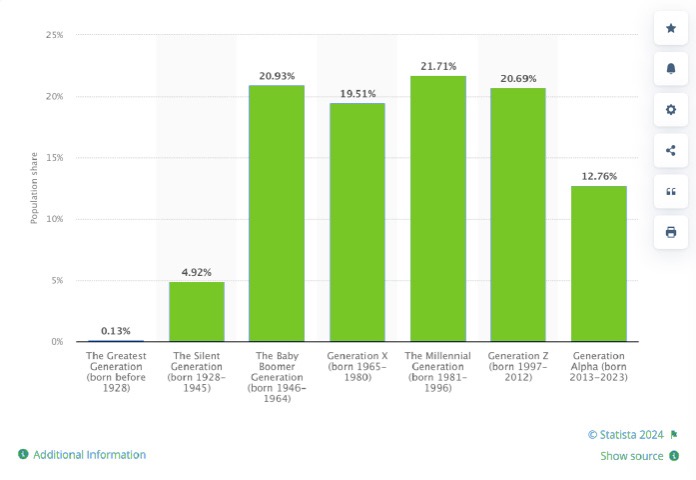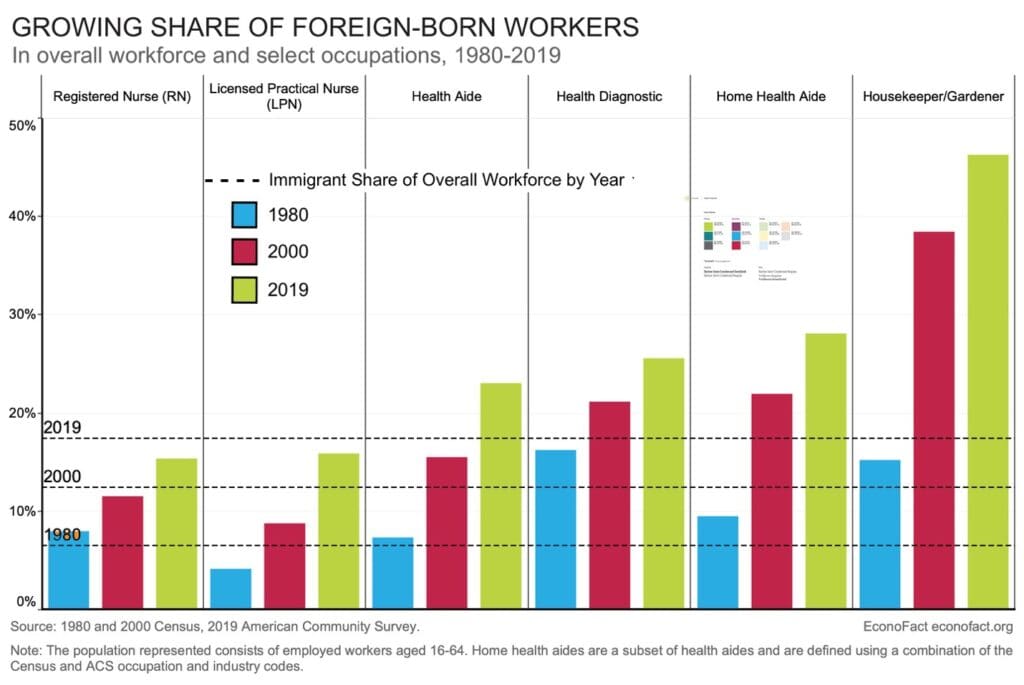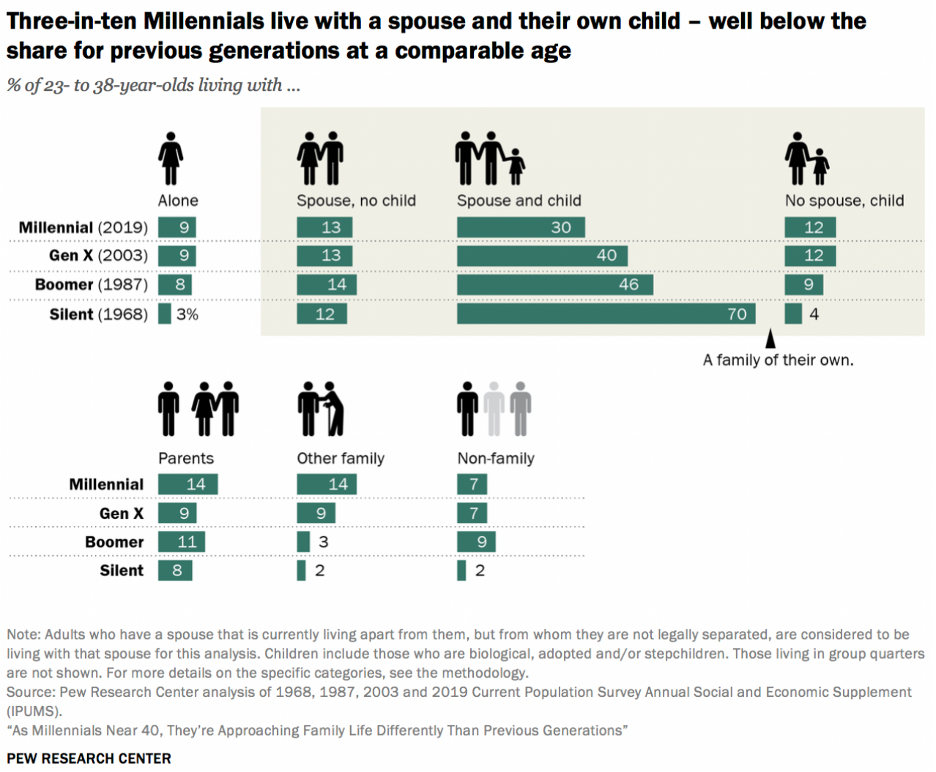
Generation X, Millennials, and the New Sandwich Generation: Are You Targeting the Right Eldercare Decision-Makers?
Generation X (born 1965–1980) was the generation of injuries from plywood bike ramps, latchkey kids, and drinking from the garden hose. Their mostly Silent Generation (1928–1945) parents were anything but helicopter parents. Millennials (born 1981–1996) wore bike helmets, attended aftercare, and drank bottled water. As birth rates dropped from 3.5% to below 2%, their baby boomer (1946–1964) parents became more involved.
In this edition of Plain Talk, we’ll look at potential generational changes to the family dynamics of eldercare and insights into the new “sandwich generation”: Generation X and millennials. How will boomers and their millennial children work together differently from the Silent Generation and their Gen X children? What will be the ramifications? Who will be the ultimate decision-maker? Will they be more or less likely to age at home versus in a home? Will their millennial children be investing time and money into parental care? To best predict the differences we can expect to see between Gen X and millennials as it relates to the care of aging parents, we’ll look at:
- What Is a Sandwich Generation?
- Sandwich Generation and Eldercare Insights
- Key Takeaways for Healthcare Marketers
- Get Expert Help With Your Sandwich Generation Marketing
What Is a Sandwich Generation?
A sandwich generation refers to adults, typically in their 40s and 50s, who are caring for both their aging parents and their own children simultaneously. The reality for the new members of the current sandwich—Generation X and millennials—often means facing the dual responsibility of managing their parents’ eldercare while also supporting their children’s needs, whether they’re young or still dependent as adults. This can create emotional, financial, and logistical challenges, making targeted eldercare marketing and clear communication essential in helping this group navigate their caregiving roles.

Sandwich Generation and Eldercare Insights
How do Gen Xers and millennials stack up against the other generations when it comes to caring for aging parents? Here are seven key factors.
1. Generational overview
Do the generations line up perfectly? No, but parentally speaking, they line up pretty well. The youngest Silent Gen-ers were 20 in 1965 when the first Gen Xers were born, and the oldest were 52 in 1980 when the last Gen Xers were born. Likewise, the youngest boomers were 17 in 1981 when the first millennials were born. The oldest boomers were 50 in 1996 when the last millennials were born. So, in both cases, the generational parental overlap is about 80%.
It’s reported that the average age of assisted living residents is around 84 years old. About half of residents are at least 85 years old, and just over 30% are between 75 and 84 years old. This means about 20% are below 75. Surprisingly, 6% are even under 65. The oldest millennials are 43. While the average age of a first-time mother in 1980 was just 22.7 years old, 6.2% of births that year were to women over 35 years old. The oldest boomers were 34 in 1980, so they only stand 14 months away from turning 80.

2. Overall parent/child relationship
Two years ago, YouGov research found that 30- to 44-year-olds were nearly 80% more likely to be estranged from an immediate family member than 45- to 64-year-olds. At that time, millennials were between 26 and 41 years old, while the older group ranged from 42 to 57.

However, this may be less of a factor with parents than it initially appears. According to a 2023 research published by the National Institute of Health, only 6% of young adults are estranged from their mothers. And, the typical age for first estrangement is 26, with over 81% reporting to have resolved their estrangement. While these numbers are low, a whopping 26% are estranged from their fathers, which usually occurs at age 23 and never resolves 30% of the time. This is particularly true of non-cis millennials who are 50% more likely to be estranged from their fathers.
Only 62% of millennials report being raised by two parents versus 71% of Gen X and 85% of boomers, which could also contribute to their high estrangement from their fathers.
Estranged children are less likely to be heavily involved in their parent’s eldercare. So, it’s safe to assume that many parents of millennials (especially men) will be going it alone or with the family support of non-child family members.

3. Parents’ living status
Two factors have changed regarding millennials’ parents’ living status compared to Gen X. First, millennials’ parents are getting divorced late in life and thus more likely to be unpartnered. Second, due to student loans and housing costs, many millennials never left their parents’ homes or found themselves moving back in.
The rise of single seniors and shifting family dynamics
With gray divorce (divorce over 50) rates more than doubling over the past 30 years, now 26% of seniors live alone in the U.S. That is double the rate for all adults in the U.S. A man can expect his standard of living to decline by 21% after a gray divorce. A woman’s standard of living will plunge by 45%. Both partners naturally see their wealth decline by half.
Within 10 years of a gray divorce, only about 22% of women and 37% of men re-partner through either remarriage or cohabitation, so most stay single. Many more millennials can expect to find their aging parents due to late-in-life personal decisions, living alone, and being less financially well-off.
This is somewhat offset by the fact that in 2022, 16% of millennials lived with their parents—up 87% from their counterparts just 20 years ago. This was likely increased due to the pandemic, and the percentage of millennials who owned houses increased from 52% to 55% from 2022 to 2023, so it’s safe to assume the percentage living with their parents dropped accordingly.
Generational cohabitation and eldercare demand
So, while millennials’ parents are more likely to live alone, which will increase the demand for around-the-clock care and facility living, a higher percentage cohabitate with their children, leading to less demand.
Traditionally, with heterosexually partnered elderly people, women live on average six to seven years longer than men, and thus eldercare for men was disproportionately handled by their more mobile wives, and the responsibility for the then-widowed mothers went to their children. Today, men only make up about one-third of long-term nursing home populations.
As more men become uncoupled and estranged from their families, the demand for in-facility eldercare among men is expected to rise over the next decade.
4. Ethnic and cultural differences
The middle birth year for Gen X was 1972. At this time, immigrants were at their lowest percentage of the population, below 5%. By 1988, the middle birth year for millennials, the number was almost 8%.

Immigrants aren’t just more likely than their American-born counterparts to care for their parents; they are, in fact, more likely to care for all American elderly.

The growing need for culturally competent senior care
The number of immigrants ages 60 and older is expected to increase sixfold from about three million in 1990 to 20 million by 2050. As the country’s immigrants age, the demand for caregivers who can communicate in their native language will grow. In a 2016 study, almost 78% of immigrants over 60 reported speaking a language other than English at home. Further, over 55% reported speaking English “less than well.” In the same study, less than 2% were found to be living in senior care centers or hospitals. Children of immigrants are generally required to be heavily involved due to their parents’ generational distrust of hospitals and doctors, language barriers, and cultural differences. While there is some variance amongst ethnic groups, the general distrust is fairly universal.

5. Wealth
Other than cases where a senior cannot make their own decisions (dementia, Alzheimer’s, etc.), the person with the money gets to make their own healthcare choices. Gen X, at $37.8 trillion, has almost two times as much wealth generationally as their Silent Generation parents at $19.7 trillion. The opposite is true for millennials. Millennials’ boomer parents, at $76.2 trillion, have over 5.5 times more wealth than their millennial children, at $13.5 trillion. And since there are 72.7 million living millennials and only 68 million living boomers, this greater than 5.5:1 ratio holds on a per-capita basis, too!

This is a huge paradigm shift. It means that even as millennials help care for their parents and assist them in their decisions, boomer parents will most often be the decision-makers. From a healthcare marketing perspective, this means that marketing dollars formerly focused on adult children should increasingly be focused on the elderly themselves.
6. Healthcare priorities
As boomer parents age into assisted care, their needs will take priority, and millennials will primarily facilitate those needs. Boomers maintain higher standards for care: 45.6% consider 4 (out of 5) the lowest acceptable rating for a provider. So, trust and high-scoring reviews will become even more crucial for providers. It is this level of autonomy that is the primary difference between boomers and the Silent Generation when it comes to eldercare decisions.

7. Parenting styles and factors
According to an article on OhioHealth.com, “The baby boomer generation struggled with the concept of child discipline, especially traditional discipline techniques from their childhoods. Baby boomers engaged in more discussions with their children and tried to be more nurturing than critical. Family meetings started with baby boomer parents who valued their children’s perspective and strived to include them in all family matters.” It goes on to state that, “Generation X homeschools more children than any other generation. Generation Xers are considered to be very protective parents, which is where the term helicopter parenting comes from.”
Seventy-seven percent of millennials value time with their families over work. Research shows that even though most families now have two working parents, millennials spend more time with their children than their parents did in the 1950s.
Financial dynamics and caregiving responsibilities between generations
Because they both hold the purse strings and are likely to echo the power position their parents took, Gen Xers are likely more authoritative with their aging, Silent Generation parents when it comes to eldercare decisions than millennials will be.
On the other hand, millennials do not hold the purse strings over their boomer parents. They were also raised in an environment that included family meetings and everyone’s opinions being valued. Because of these factors, they will likely be relegated to influencers and not deciders.
Expect fewer aging boomers as a percentage to receive personal assistance, time, or money from their kids than the Silent Generation. This is partly because, as a whole, they don’t need it, and their millennial kids don’t have it. (Over 73% of millennials report living paycheck-to-paycheck.) Further, 32% are single parents, so if aging dependent parents are to live with them, they will likely be expected to contribute either money or child-rearing.
In fact, the opposite might lead to them contributing time to their aging parents. Before the pandemic in 2019, 14% of millennials lived with their parents, and another 14% lived with other family members, like siblings, aunts, or grandparents. Many fewer lived with a spouse and child than previous generations did at the same age. Plus, over a quarter of them receive financial assistance from their parents.

8. Takeaway Insights for Healthcare Marketers
Gender-specific healthcare messaging
Given that 66% of long-term nursing home residents are currently women, healthcare marketing strategies should focus on addressing the needs and concerns of this demographic—particularly around chronic conditions and long-term care. However, with the anticipated rise in boomer men entering nursing homes over the next decade, you’ll need to adapt your messaging and services to cater to the unique healthcare needs and preferences of older men as well. This could involve emphasizing men’s health issues, lifestyle preferences, and wellness programs tailored specifically to their needs. You may also need to adjust the tone and approach of communications to better engage male audiences. And don’t neglect family dynamics. Men may be less likely to seek help early, requiring more targeted outreach and education efforts.
Multicultural campaigns
While immigrants are more likely to care for their parents, because of the demographic changes, there will be a growing demand for non-English-speaking caregivers. You can expect to see a rise in non-English-speaking live-in facilities as demographic changes unfold. With less than 2% of senior immigrants currently living in such facilities, however, the demand will likely grow for non-English-speaking senior daycare and in-home care services. For healthcare marketers, this presents an opportunity to target this growing segment by creating bilingual or multicultural campaigns that resonate with immigrant families and highlight in-home care options and senior daycare services in their native languages. You can also emphasize the cultural and linguistic diversity of caregiving staff to build trust and appeal to these communities.
Shifting targets and decision-makers
Expect a shift in how you market senior facilities to patients and who your targets are. In most cases, the parents will be more prominent in the decision process. Further, in a more collaborative family culture, it is less likely that millennials will dictate their parent’s care than with past generations.
This dynamic will play out with in-home care too. Whereas it was more likely that the Silent Generation patient was living in their Gen X child’s home, the opposite is now true. For generational cohabitant situations, expect that it will be more likely that the boomer patient is the homeowner and the millennial child is living with them. This, again, makes it more likely that the boomer patient is the primary decider. Focus on messaging that empowers boomers as decision-makers, highlighting in-home care services that cater to their needs and preferences while addressing family dynamics.
Transparency and technology
With boomers driving their healthcare, trust becomes the most important factor. It becomes more important than convenience. Reviews also become even more important than they already are. Additionally, despite who’s paying, millennials will increasingly need to assist their aging parents. Millennials value online experience and financial transparency. Review your website experience, values, and messaging. In inpatient environments, technology to facilitate communication is also extremely important. Look for technologies that support and improve teleconferencing.
Get Expert Help With Your Sandwich Generation Marketing
If you’d like to discuss your senior care marketing strategy for boomers or have questions about this article, feel free to send us a note or call 502-499-4209. We’d love to hear from you!
Our Articles Delivered
Signup to receive our latest articles right in your inbox.




